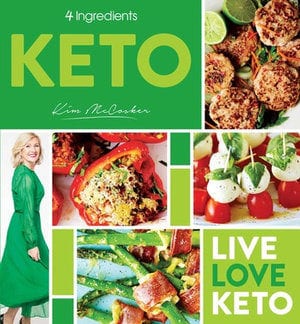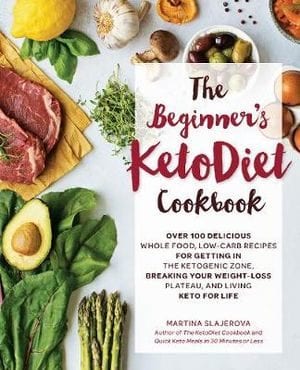This post contains affiliate links.
The keto diet was originally developed in the 1920s to treat epilepsy in children. It is a diet that offers metabolic flexibility with plenty of benefits that extend to all parts of the body, including mind and soul. This post is titled ‘Ketosis for Dummies’ because it contains all you need to know about the keto diet if you’re completely new to it.

The keto diet plan restricts carb intake while increasing the consumption of fats. The goal of a keto diet is to take the body into ketosis. Ketosis is when the liver turns fat into ketone bodies, which will become the body’s main source of energy.
Ketosis for Dummies – What Beginners Need To Know
A keto diet plan’s main objective is for the body to lose weight to achieve wellness, health, and proper hormone, insulin, and organ function. The keto lifestyle helps to remove commercially produced and unnatural chemicals from entering our bodies by observing healthy eating.
With keto, you only eat healthy proteins, carbohydrates, fats, and proper minerals and vitamins.
How Keto Works
Keto is a medical diet, and it comes with serious risks. It involves consuming low-carb and high-fat diets. It forces the body to use ketone bodies to fuel energy into the body. The liver has to make ketone bodies when you deprive yourself of carbohydrates. It takes a few days for you to reach ketosis.
Keto requires you to eat fat with each meal. The exact ratio of calorie intake will depend on your individual needs. You can also consume healthy unsaturated fats such as nuts, avocados, seeds, tofu, and olive oil and high amounts of saturated fats from butter, oils, lard, and cocoa butter.
Protein in keto is derived from proteins with high saturated fats like salmon, bacon, pork, and beef. The fruits and vegetables allowed in keto are berries in small portions and leafy greens like spinach, Swiss chard and kale, broccoli, cauliflower, Brussels sprouts, bell peppers, asparagus, garlic, cucumber, onions, celery, and summer squashes.

Who Benefits From Keto?
The primary goal of keto is weight loss. However, there are plenty of benefits that come naturally when one is on the keto diet plan. By eliminating high carbohydrate and sugar intake, the body detoxifies itself and heals from accumulated inflammation. Studies have found that when a keto diet is followed over the long term, significantly reducing body weight and body mass index in patients as well as reducing levels of triglycerides, LDL cholesterol and blood glucose, and increased the level of HDL cholesterol.
Therefore if you have skin conditions like eczema, acne, psoriasis, dandruff, and rosacea, a keto diet will heal your ailment. People with mental fatigue, muscle weakness, joint pain, and migraines can get relief while on the keto diet. These include health conditions like Alzheimer’s, autism, diabetes, heart conditions, hypertension, and depression, among others; Keto is known to reduce blood sugar and insulin levels. It is also whispered that keto improves fertility.
Transitioning to Keto the Healthy Way
Transitioning your body from sugar burning mode to fat-burning takes two to six weeks depending on one’s sugar dragon, mindset, and metabolic state.

Unless you are eating clean, jumping into keto can be quite challenging. The first step in your keto journey should be eliminating carbohydrates, refined sugars, processed foods, and artificial foods. Toss away the bread, sugary drinks, pasta, sweets, cereals, energy bars, and alcohol, among many others.
There are simple keto-friendly recipes you can start with, but before that, you should test your blood ketones and be able to monitor your carb intake to know if you have gone into ketosis.
Please note that transitioning to ketosis can cause fatigue, headaches, and withdrawals, so you have to be prepared. But remember, with all of these side effects, there are many health benefits.
Understanding Keto Risks
One of the major risks with following the Keto Diet are its cardiovascular risk factors. Keto is a high-fat diet, there is a particularly high consumption of saturated fats, which are linked to heart disease and bad cholesterol. It is recommended that you keep your saturated fats under 7% of your daily calorie intake.
It can also cause nutrient deficiency if you are not eating a variety of fruits, vegetables, and grains. This will lead to defects in micronutrients, including phosphorus, magnesium, vitamin B and C and selenium.
Liver problems can get worse due to high-fat metabolism. Keto can also overload the kidney and slow its ability to metabolize proteins. You are advised to consume protein an average of 46 grams every day if you are a woman and 56 grams if you are a man.
Since the keto diet is low in fibrous foods such as legumes and grains, it can cause constipation.
Sometimes the brain needs healthy carbohydrates to function correctly. A low carb diet like keto can cause irritability and confusion.
These risks can increase, so you should speak to your doctor and a nutritionist for the proper planning of your diet.

Quick Diet Tips for Healthy Keto Results
If your keto diet is successful for you emotionally, cognitively and nutritionally, then keep it up. But, if you are experiencing challenges or not feeling well, do not worry, this is ketosis for dummies, after all, it’s all new. All you need to do is re-evaluate your situation by taking the following steps:
- Listen to your body – Some dieters may decide to incorporate dairy into their diet while others will not. Your body’s response and reaction to certain foods will tell you what you should change and how to customize your keto diet.
- Upgrade your nutrient quality as much as you can
- You should consume grass-fed, and pasture-raised meats, organic produce, wild seafood, and healthy anti-inflammatory fats. Do away with seed and vegetable oils.
- Get in and out of ketosis – Try to cycle in and out of ketosis to train your body to be flexible in the sources of fuel it burns. Cycling in and out of ketosis will also give the body a break.
- Change lifestyle habits – For best results and maximum benefits from keto, you should stick to your diet plan and adhere to a healthy lifestyle. Incorporate exercise in your diet, always staying hydrated, and getting ample sleep. Eliminate additional stressors and toxins from your body too.
Keto for Beginners Books
Keto for Beginners Books at Dymocks Australia
 CLICK TO VIEW DETAILS |  CLICK TO VIEW DETAILS |  CLICK TO VIEW DETAILS |  CLICK TO VIEW DETAILS |
|---|---|---|---|
| 4 Ingredients Keto by Kim McKosker | The Beginners Keto Diet Cookbook by Martina Slajerova | Simply Keto by Suzanne Ryan | The Complete Ketogenic Diet for Beginners by Amy Ramos |
Keto for Beginners Books at Amazon.com
Conclusion
Living healthy on keto requires your commitment to the diet rules to the latter. Before starting keto, you should have your goals and stick to them. Ask yourself if you are ready for keto and the challenges that come with it. There is no point of trying it if you can’t stick with it to the end and reap the benefits.
Once you have decided to go the keto way, focus on eliminating the bad carbs, and focus on veggies, whole grains, legumes, and fruit to meet the carbohydrate needs for your body. Eat fat in plenty to help the body function properly. You will get energy, burn fat and absorb vitamins A, D, E and K, and many other functions.
A keto diet allows you to live a healthy life after completion. From stories of people who have been healed from diabetes and had skin problems cleared to people with high blood pressure reversed, the Keto diet is an all-ages diet incorporating both children and adults alike. Although this ketosis for dummies guide is comprehensive, we do recommend you consult your doctor before starting the diet.
This is a guest post.
Pin for later


- Ketosis for Dummies - July 25, 2019
